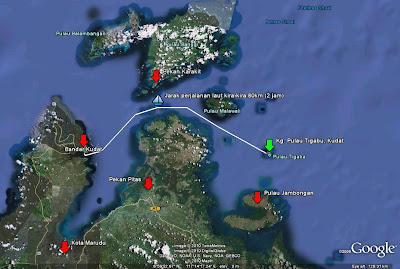US Ambassador to Malaysia visits the proposed Tun Mustapha Park
Posted by: Lee Yoke Lee
The Kudat-Banggi Priority Conservation Area (KBPCA) is where two tumultuous seas meet: the Sulu Sea to the east and the South China Sea to the west. KBPCA seems plain-looking compared to her glamorous sisters Sipadan and Langkayan that are already the mainstays of marine tourism in Sabah. But underneath those grey skies, whipping winds and choppy waters that make it less than picture perfect, KBPCA disguises her riches: productive fishing grounds that feed thousands; diverse and mostly intact marine and coastal habitats; as well as the resilient fishing communities dotting the coastline. It was these riches that the US Ambassador to Malaysia Paul W. Jones came to see on 11 March 2011.
The Ambassador is witnessing a large-scale Marine Protected Area (MPA) in the making; a grand experiment in collaborative management of coastal and marine resources. Almost twice the size of Delaware, the proposed Tun Mustapha Park is already building strong foundations for sustainability: alternative livelihood programmes; education and awareness; and an ongoing and meaningful consultative process in natural resource management.
MPAs typically strike fear in the hearts of those who rely solely on marine and coastal resources. Pulau Maliangin is therefore a demonstration site to show stakeholders the potential benefits of well-managed MPA. Members of the Maliangin Island Community Association (MICA) welcomed Ambassador Jones and representatives from the National Oceanography Directorate, Sabah Parks, Department of Fisheries Sabah, Universiti Malaysia Sabah, WWF and a Sabah-based journalist. MICA showcased their finely woven mats made from the nipah palm, one of the many products being looked into as part of the alternative livelihood programme promoted by WWF-Malaysia.
The Ambassador and the group also visited a long-established program in Karakit in Pulau Banggi. Through its fun and innovative activities, the Banggi Environmental Awareness Center (BEAC) reaches out to the island community particularly young people. It is also a highly accessible resource center for those seeking printed material and multimedia on the marine environment and English language. Students of S.K. Karakit were thrilled to meet Ambassador Jones and the group at BEAC where winners of a coloring contest received prizes. Programs like BEAC also help island communities understand the rationale behind the creation of MPAs.
The conservation of KBPCA is a long-term commitment that WWF-Malaysia has undertaken in collaboration with the local government and the communities. Through USAID’s Coral Triangle Support Partnership (CTSP), many of the essential on-the-ground conservation programs continue to help build momentum for the proposed Tun Mustapha Park to be a viable and successful MPA that serves both conservation and socioeconomic goals.



Comments
Post a Comment